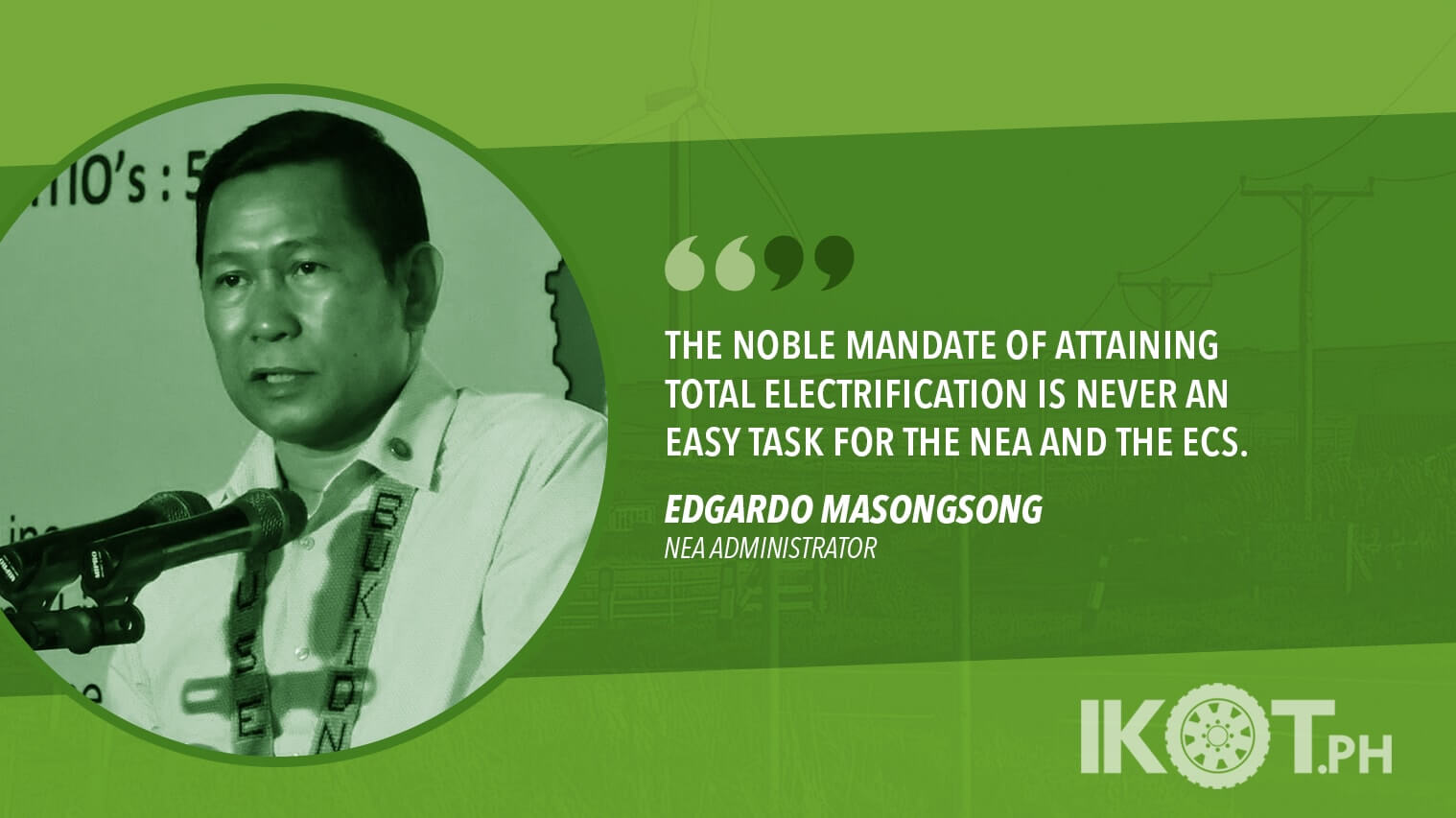Government’s electrification projects, including the Sitio Electrification Program (SEP), will receive P1.5 billion in the proposed budget of the National Electrification Administration (NEA) for fiscal year 2020 based on the National Expenditure Program (NEP).
This was revealed by NEA Administrator Edgardo Masongsong when he presented the agency’s 2020 proposed budget based on NEP before the members of the House Committee on Appropriations on Tuesday (August 27).
“The NEA and ECs will remain steadfast in their commitment, despite all odds, to make possible the total electrification target.”
The state-run agency, based on the 2020 NEP, is allocated P14.147-billion corporate operating budget (COB). Of the amount, P1.746 billion will be financed by the NEA’s internally generated funds, P1.531 billion as subsidy from the national government (NG), and the P10.869 billion represents non-cash subsidy for the conversion of NG advances.
Based on expense class, P10.869 billion (77 percent) is non-cash item for Department of Finance-approved conversion of NG advances into subsidy; P2.6 billion (18 percent) for Maintenance and Other Operating Expenses (MOOE); P350 million (2 percent) for personnel services; P261 million (2 percent) for capital outlay; and P65.94 million (1 percent) for financial expenses.
On the government’s electrification projects, Masongsong said a bigger portion of the P1.531-billion NG subsidy is dedicated to the continued implementation of the SEP Phase II at P1.162 billion. This amount, however, will only allow the agency to energize 775 sitios next year, as electrifying a sitio costs at least P1.5 million on the average.
The proposed budget will also allow the agency to meet its targets for 2020, which include energization of 775 sitios, electrification of 38 LGU/NGOs resettlement sites, and provision for the cost counterpart of the Government of the Philippines on JICA donation for ECs in the Bangsamoro region.
The NEA’s other operational targets also cover the connection of additional 460,000 consumers, reduction of system loss to 11 percent, collection efficiency of 96 percent, release of P245 million loans to the ECs, and continued realization of a net margin from the agency’s financial operation.
“We would really thank (the House Committee on Appropriations) if there would be more funding for total electrification.”
Masongsong, in his statement during the budget hearing, reaffirmed the NEA and the ECs’ unwavering commitment to help the national government realize the 100-percent household electrification target by 2022, despite the many challenges.
“The noble mandate of attaining total electrification is never an easy task for the NEA and the ECs,” Masongsong said, as he identified some implementation problems, such as accessibility, peace and order, calamities, right-of-way issues, poverty, and limited government subsidy, among others.
The NEA chief also cited a number of measures and funding sources to fasten efforts to achieve the total electrification goal, which include government subsidies, funding under DOE’s Energy Regulation No. 1-94 program, Qualified Third Party (QTP) program, private sector participation, donations or grants from both local and foreign institutions, and EC’s capital expenditure program.
“The NEA and ECs will remain steadfast in their commitment, despite all odds, to make possible the total electrification target, providing in effect a platform for the government to draw rural people into the economic and social mainstream and vigorously pursue its goal of inclusive growth,” Masongsong said.
Meanwhile, Rep. Sergio Dagooc of the Association of Philippine Electric Cooperatives (APEC) party-list, said the budget recommended by the DBM for the government’s electrification program is “very small,” given the thousands of sitios still left without electricity connection.
“With a limited budget the NEA will have next year and the same budget for the succeeding years, how can the government attain the total electrification?” Dagooc asked. “Maybe the Office of the President and the Department of Budget and Management should strongly consider giving more budget or subsidy to aggressively realize the total electrification.”
The lawmaker also noted that the government “cannot simply rely” on the private investors to fund the electrification program, considering that it is now on the “last mile.” He urged the House Committee on Appropriations to “seriously consider” the NEA’s original budget proposal for 2020.
The NEA submitted at least P6.146-billion budget proposal to the DBM to bankroll the government’s various electrification projects, including SEP and Barangay Line Enhancement Program. But the DBM only recommended P1.531 billion.
Masongsong reiterated that the agency, together with the Department of Energy, is considering a number of options to fast-track the total electrification. “But we would really thank (the House Committee on Appropriations) if there would be more funding for total electrification,” the NEA chief added.
Rep. Presley De Jesus of the Philippine Rural Electric Cooperatives Association (PHILRECA) party-list, pointed out that it is the primary obligation of the government to fund the rural electrification program.
To date, the NEA through its partnership with 121 ECs nationwide has energized 13,184,523 households–translating to 61 million Filipinos in the countryside. About 14,876 sitios, however, are still left without access to electricity. To complete the energization of these sitios by 2022, the state-run agency will need approximately P22 billion.
For the first semester of the current year alone, the NEA was able to energize 469 sitios, start enhancement of grid line connection for 20 barangays, connect additional 281,246 electricity consumers, attain an average system loss of 11.12 percent, sustain 100 percent collection efficiency, release P405 million worth of loans to ECs, and maintain a positive margin for the period.

